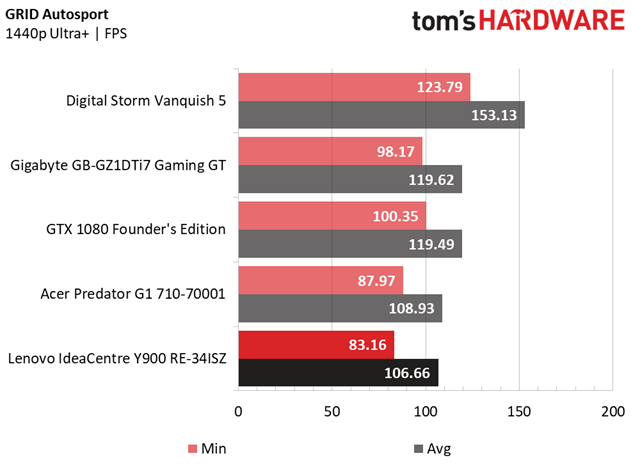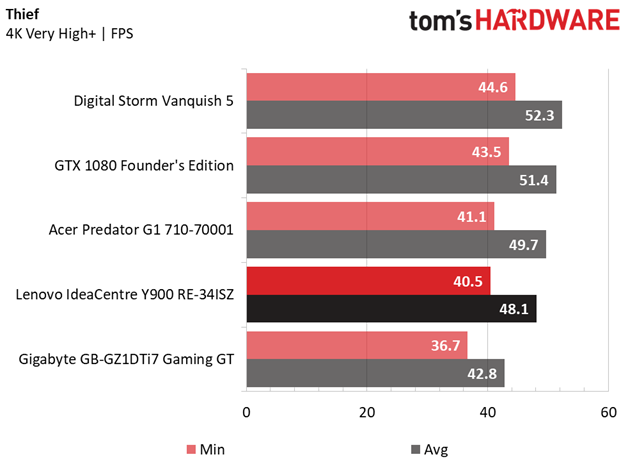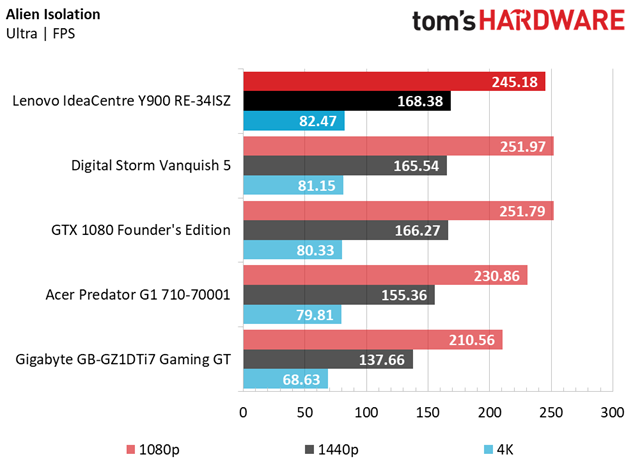Lenovo IdeaCentre Y900 Razer Edition Review
Why you can trust Tom's Hardware
Gaming Benchmarks
Alien: Isolation
Switching to purely gaming workloads, the Lenovo IdeaCentre Y900 Razer Edition starts our round of benchmarks off with impressive performance against the competition, averaging the highest framerates at 2560 x 1440 and 3840 x 2160. However, 1920 x 1080 is another story, where the Y900 falls to third place. However, these framerates are nothing to be ashamed of; the system averages just over 80 FPS with the eye candy turned all the way up at 4K. And all of these scores are relatively close.
Ashes of the Singularity
Once again, the Lenovo seems to struggle behind the other GTX 1080-equipped systems at 1080p, falling behind even the Acer Predator G1 (and its less-powerful processor). However, as the resolution gets higher (and the GPU has to work more), the Lenovo pulls ahead of the pack, trailing only the Vanquish 5 at 2560 x 1440 and leading the pack at 4K. It seems as if the platform is struggling with power delivery and having trouble deciding when to initiate CPU and GPU boost states.
The temperatures are still not to blame for this strange behavior (we’ve barely hit 80°C in our game tests so far), and GPU-Z has consistently shown Pwr and VRel warnings while testing (particularly at 1080p), which indicates issues with power delivery. The GPU still enters the boost state, but it’s not for long periods of time, and it usually occurs coinciding with the aforementioned GPU-Z warnings. We also observed Nerve Center taking up to 5% of the CPU resources, but at this point, we’re suspecting it has less to do with software and everything to do with the platform’s power phase design.
Bioshock Infinite



The Lenovo IdeaCentre Y900 Razer Ediiton seems to offer more stable performance in Bioshock Infinite, sliding into the third-place position at all tested resolutions behind our GTX 1080 Founder’s Edition-equipped test rig and above Acer’s Predator G1. Even at 4K, the Y900 easily averages above 60 FPS, but the minimum framerate is indicative of high frame time variances, which could be an issue caused by sub-par power delivery. However, at 2560 x 1440, the Lenovo scores the best minimum framerate (we reran the tests to be sure). The Y900 Razer Edition’s performance thus far has left us scratching our heads.
DiRT Rally



DiRT Rally isn’t particularly taxing at 1920 x 1080 and 2560 x 1440, with all of the PCs achieving excellent framerates (even the GTX1070-equipped Gigabyte Gaming GT nets just under 60FPS) when the settings are cranked to the maximum. However, at 4K, the bottleneck quickly shifts and the Lenovo IdeaCentre Y900 Razer Edition takes its proper place in the lineup, beating out our test bed (at stock CPU settings) with its modest overclock but falling short of the Digital Storm Vanquish 5 (which has a slightly higher overclock) by an extremely small margin.
Grand Theft Auto V



The Lenovo IdeaCentre Y900 Razer Edition falls into a familiar place in GTAV performance, falling behind the Acer Predator G1 at 1920 x 1080. However, the Lenovo pulls ahead of the G1 at 2560 x 1440 and 4K (another familiar occurrence), but it still comes up short against our test bed, albeit by an extremely small margin. The GPU struggled with whether or not it should go into a boosted state at lower resolutions, with the clock rates mostly riding the base frequency of 1607 MHz, despite no indication of thermal throttling.
GRID Autosport



The GRID Autosport results sees the Lenovo IdeaCentre Y900 Razer Edition jumping position at every tested resolution. At 1080p, it falls behind even the Gigabyte Gaming GT (with a GTX 1070), but it still pushes enough performance to beat out the Acer Predator G1. However, moving up to 2560 x 1440 puts the Lenovo in dead last. The 3840 x 2160 results are even more perplexing, with the Lenovo taking a position below our GTX 1080 Founder’s Edition test bed and above the Acer Predator G1.
Get Tom's Hardware's best news and in-depth reviews, straight to your inbox.
We theorize that new driver updates could have affected performance in GRID Autosport from the time we tested our reference rig and the Digital Storm Vanquish 5. We also see the CPU playing a role in these strange results, as the game couldn’t hold a steady clock rate throughout the benchmark (we observed short-lived peaks of 4.4 GHz, with the processor mostly staying around 4.3 GHz. Even more bewildering, there was no evidence of thermal throttling.
Hitman



The Hitman results in DX12 also tell a similar story, with the Lenovo IdeaCentre Y900 Razer Edition placing dead last among its GTX 1080-equipped brethren at 1920 x 1080 and 2650 x 1440. However, cranking the resolution up to 3840 x 2160 sees the Lenovo shoot to the top of the chart, averaging almost 5 FPS more than the Digital Storm Vanquish 5, despite having the worst minimum framerate in the group.
Metro: Last Light Redux



The Metro: Last Light Redux benchmark results show the Lenovo IdeaCentre Y900 Razer Edition at the bottom of the GTX 1080 barrel at 1080p and 1440p, beating only the GTX 1070-equipped Gigabyte Gaming GT. Again, we observed the GPU failing to reach its boost frequency, mostly settling at its base clock of 1607 MHz. Cranking the resolution up to 3840 x 2160 gives it a leg up over the Acer Predator G1, but it still falls precariously short of our reference PC and the Vanquish 5, which sport GPUs with the exact same clock rate. However, the Vanquish 5 and our test rig were likely not having any issues with the GPU reaching its boosted clock frequency.
Rise of the Tomb Raider
In another surprising turnout, the Lenovo IdeaCentre Y900 Razer Edition sits at the top of the heap in the Rise of the Tomb Raider benchmark, besting even the Digital Storm Vanquish 5 at all tested resolutions. We noticed the Lenovo maintained rock-solid CPU and GPU clock rates in this particular game, and we’re now more than convinced that the erratic nature of the Y900 Razer Edition’s performance lies in its Lenovo-crafted power phase design, which seemingly has a mind of its own, depending on the game.
The Division
The Lenovo IdeaCentre Y900 Razer Edition seems to have finally found its legs, and similar to the ROTR results, it bests the Digital Storm Vanquish 5 at all tested resolutions. However, another anomaly occurs in these results: our test bed manages to push ahead of both the Lenovo and Digital Storm offerings at 2560 x 1440 and 3840 x 2160, despite the two machines having a higher CPU clock rate. This could be due to driver differences at time of testing. Either way, the Y900 Razer Edition is in the proper performance ballpark in The Division.
Thief



We may have spoken too soon about the Lenovo finding its groove; the IdeaCentre Y900 Razer Edition finishes our benchmark suite at the bottom of the Thief charts at 1920 x 1080 and 2560 x 1440, getting upended by even the Gaming GT and its GTX 1070. However, once the bottleneck shifts to the GPU at 3840 x 2160, we see the Lenovo pull ahead of the Gaming GT, and it take its place at the bottom of the pile of GTX 1080-equipped PCs. Once again, we observed erratic CPU and GPU clock rates in this game (with zero evidence of thermal throttling).
MORE: Best PC Builds
MORE: How To Build A PC
MORE: All PC Builds Content
Current page: Gaming Benchmarks
Prev Page Synthetic & Productivity Benchmarks Next Page Price Analysis & ConclusionDerek Forrest was a contributing freelance writer for Tom's Hardware. He covered hardware news and reviews, focusing on gaming desktops and laptops.



